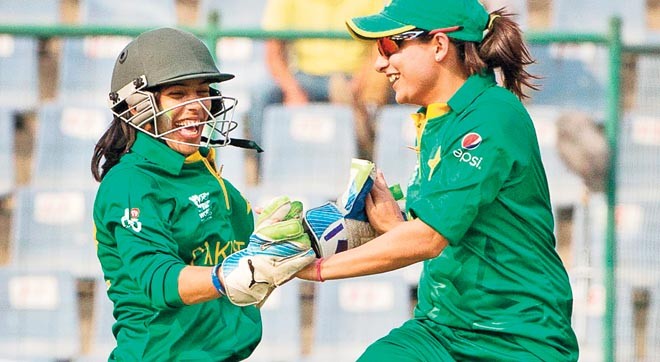

Pakistan have been all but eliminated from the Women’s World Cup at the time of writing this piece on Friday. Barring a win in the match against New Zealand, which would’ve taken place on Saturday, the national side would be formally knocked out of the competition as well.
Expectations for the national women’s side, which has had to face more off-field hurdles than on the ground, have soared since last year’s T20 World Cup. Not only did Pakistan finish third in the group, they also famously beat India in their second nail-biting win over the archrivals in WT20s -- the first being in 2012.
The result coupled with an early exit for the men’s side in the same tournament, in addition to a walloping against India, which meant that the Girls in Green became the toast of the country’s cricket aficionados, even if temporarily.
But what many of the current cricket analysts don’t realise is that unlike the men’s version, T20s and ODIs are completely different sports in the women’s game -- similarly to what ODIs and Tests would be in the case of the former.
For instance, Pakistan, who were overpowered by India despite being restricted to 169 in the first innings of their World Cup encounter, have never beaten India in 10 ODI matches, despite two World T20 wins.
The gap in fitness level and stamina required for 20 and 50 overs cricket was palpable when Pakistan’s opening fast bowlers Asmavia Iqbal and Diana Baig were tiring at the end of their spells against Australia on Wednesday, despite a promising start.
Diana and Asmavia had Australia 18-2 after 10 overs with one wicket each. The defending champions and favourites more than tripled their score in the next 10 overs, eventually finishing with 290 and winning their fourth win out of four -- it was Pakistan’s fourth defeat in four.
Pakistan’s temporary upper hand in the opening skirmishes against a world class Australian batting lineup epitomised the national side’s brief encounters with dominance throughout their World Cup campaign. Barring the match against England -- which was a complete landslide courtesy of centuries from Heather Knight and Natalie Sciver -- Pakistan have been in front at some point in each of the other three matches against, South Africa, India and Australia.
Most of the impetus for that has been provided by the bowlers, who dragged South Africa back from 113 without a loss in the 26th over to 177-7 in the 46th, in the opening World Cup game, before SuneLuus and Shabnim Ismail saw South Africa home in their pursuit of 206.
The bowling performances against South Africa and India, and the opening burst against Australia, have largely been encouraging.
Diana and Asmavia seem to be decent pacers who can be groomed further to improve their speed and consistency. Nashra Sandhu and Sadia Yousuf, who took six wickets between them against India, are both promising left-arm spinners, and yet with clear distinctions. Nashra bowls from closer to the wickets, while Sadia is round-armed, and they when coupled with captain Sana Mir -- who’s been among the wickets and runs, in addition to leading in the field as well -- form a decent spin trio.
Pakistan’s fielding has blown hot and cold in the tournament, with dropped catches and misfields coupled with brilliant takes and athletic shot stopping. The difference this inconsistency makes can be understood by Sadia Yousuf dropping a straightforward catch at deep backward square leg when Australia’s Elyse Villani was at 7 -- she went on to make a quick-fire 59 off 40 balls, with 4 mighty sixes.
At the same time Pakistan were staggering in the field against India, as demonstrated by Sana Mir’s catch of the dangerous Harmanpreet Kaur, and Diana Baig’s dynamic attempt to save a six.
Even so, the most inconsistent feature of Pakistan’s play remains their batting, which has fared inexplicably in two consecutive run chases against India and Australia. In both cases, the batters decided to go in their nutshell, almost blatantly refusing to score any runs. While chasing India’s 169, one might’ve understood the rationale, but when they needed a run a ball against Australia, the top four cumulatively scoring 4 boundaries in 86 balls -- which add up to 14.2 overs -- made little sense.
Of course these are the things one learns through experience. The gap in dexterity and pedigree between the likes of Australia and Pakistan is such that intimidation can creep in. But it would be completely wrong to suggest that this gap isn’t decreasing, however slowly.
Nahida Khan’s 79 against South Africa and Ayesha Zafar’s unbeaten 56 against England -- both quality bowling lineups -- prove that Pakistani batters can produce against the best, individually. It is now about transforming those occasional individual performances into team efforts on a more consistent basis.
Only those who haven’t followed women’s cricket at all would’ve expected Pakistan to make it to the semis in the 50-over format. But a win or two against the bigger sides would’ve laid the foundation for future growth and would be set as benchmarks for encouragement.
Pakistan take on Sri Lanka and West Indies in their final two World Cup matches, both of whom have zero wins out of four as well, at the time of writing. Pakistan have traditionally fared better against Windies and Sri Lanka; they now have a chance to finish the tournament on a high.
This article was published in The News on Sunday on July 9, 2017 under the title Pakistan Women show promise, despite early elimination.